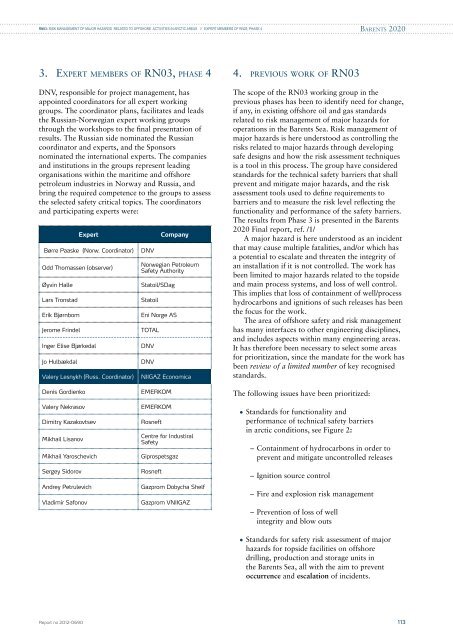phase 4 report - DNV
phase 4 report - DNV
phase 4 report - DNV
Create successful ePaper yourself
Turn your PDF publications into a flip-book with our unique Google optimized e-Paper software.
RN03: RISK MANAGEMENT OF MAJOR HAZARDS RELATED TO OFFSHORE ACTIVITIES IN ARCTIC AREAS // Expert members of RN03, <strong>phase</strong> 4Barents 20203. Expert members of RN03, <strong>phase</strong> 4<strong>DNV</strong>, responsible for project management, hasappointed coordinators for all expert workinggroups. The coordinator plans, facilitates and leadsthe Russian-Norwegian expert working groupsthrough the workshops to the final presentation ofresults. The Russian side nominated the Russiancoordinator and experts, and the Sponsorsnominated the international experts. The companiesand institutions in the groups represent leadingorganisations within the maritime and offshorepetroleum industries in Norway and Russia, andbring the required competence to the groups to assessthe selected safety critical topics. The coordinatorsand participating experts were:ExpertBørre Paaske (Norw. Coordinator)Odd Thomassen (observer)Øyvin HalleLars TronstadErik BjørnbomJerome FrindelInger Elise BjørkedalJo HulbækdalValery Lesnykh (Russ. Coordinator)<strong>DNV</strong>CompanyNorwegian PetroleumSafety AuthorityStatoil/SDagStatoilEni Norge ASTOTAL<strong>DNV</strong><strong>DNV</strong>NIIGAZ Economica4. previous work of RN03The scope of the RN03 working group in theprevious <strong>phase</strong>s has been to identify need for change,if any, in existing offshore oil and gas standardsrelated to risk management of major hazards foroperations in the Barents Sea. Risk management ofmajor hazards is here understood as controlling therisks related to major hazards through developingsafe designs and how the risk assessment techniquesis a tool in this process. The group have consideredstandards for the technical safety barriers that shallprevent and mitigate major hazards, and the riskassessment tools used to define requirements tobarriers and to measure the risk level reflecting thefunctionality and performance of the safety barriers.The results from Phase 3 is presented in the Barents2020 Final <strong>report</strong>, ref. /1/A major hazard is here understood as an incidentthat may cause multiple fatalities, and/or which hasa potential to escalate and threaten the integrity ofan installation if it is not controlled. The work hasbeen limited to major hazards related to the topsideand main process systems, and loss of well control.This implies that loss of containment of well/processhydrocarbons and ignitions of such releases has beenthe focus for the work.The area of offshore safety and risk managementhas many interfaces to other engineering disciplines,and includes aspects within many engineering areas.It has therefore been necessary to select some areasfor prioritization, since the mandate for the work hasbeen review of a limited number of key recognisedstandards.Denis GordienkoValery NekrasovDimitry KazakovtsevMikhail LisanovMikhail YaroschevichSergey SidorovAndrey PetrulevichVladimir SafonovEMERKOMEMERKOMRosneftCentre for IndustiralSafetyGiprospetsgazRosneftGazprom Dobycha ShelfGazprom VNIIGAZThe following issues have been prioritized:• Standards for functionality andperformance of technical safety barriersin arctic conditions, see Figure 2:––Containment of hydrocarbons in order toprevent and mitigate uncontrolled releases––Ignition source control––Fire and explosion risk management––Prevention of loss of wellintegrity and blow outs• Standards for safety risk assessment of majorhazards for topside facilities on offshoredrilling, production and storage units inthe Barents Sea, all with the aim to preventoccurrence and escalation of incidents.Report no 2012-0690 113






![Risk Based Pipeline Integrity Management [Compatibility Mode] - DNV](https://img.yumpu.com/50424229/1/190x146/risk-based-pipeline-integrity-management-compatibility-mode-dnv.jpg?quality=85)









